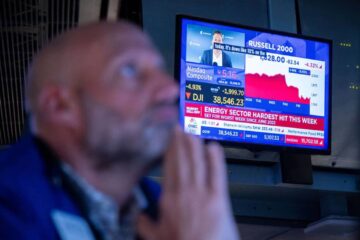“Inflation remains elevated, reflecting supply and demand imbalances related to the pandemic, higher energy prices, and broader price pressures,” the Fed said.
Updated at 2:41 pm EST
The Federal Reserve made its largest rate hike in more than two decades Wednesday, while confirming plans to reduce its $9 trillion balance sheet, but added that follow-on moves would be ‘appropriate’ to the health of the broader economy.
The Fed lifted its Fed Funds rate by 50 basis points, to a range of 0.75% to 1%, and said near-term rate moves would be “needed in order to combat the faster since the early 1980s.
The central bank also confirmed plans to reduce its $8.9 trillion balance sheet, with $47.5 billion in sales starting on June 1 with a cap its monthly asset sales at $95 billion, comprised of $60 billion in Treasury bonds and $35 billion in mortgage bonds. That a pace is around twice as fast as the Fed’s prior balance sheet run-off in 2017.
The twin policy tightening efforts constitute one of the most aggressive Fed responses in decades as consumer price pressures continue to surge amid record high gas prices, a rally in crude oil triggered in part by Russia’s war on Ukraine and ongoing supply chain disruptions linked to China’s inability to manage its 2022 Covid resurgence.
“Although overall economic activity edged down in the first quarter, household spending and business fixed investment remained strong. Job gains have been robust in recent months, and the unemployment rate has declined substantially,” the Fed said. “Inflation remains elevated, reflecting supply and demand imbalances related to the pandemic, higher energy prices, and broader price pressures.”
“The invasion of Ukraine by Russia is causing tremendous human and economic hardship. The implications for the U.S. economy are highly uncertain,” the statement added. “The invasion and related events are creating additional upward pressure on inflation and are likely to weigh on economic activity. In addition, COVID-related lockdowns in China are likely to exacerbate supply chain disruptions. The Committee is highly attentive to inflation risks.”
U.S. stocks pared earlier gains following the Fed decision, with the Dow Jones Industrial Average marked 112 points higher on the session and the S&P 500 rising 7 points. Benchmark 10-year Treasury note yields, meanwhile, edged down to 2.975%.
The CME Group’s FedWatch tool suggests at least a 91.5% chance of another 50 basis point hike in June, while 2-year note yields rose to 2.793% as Fed Chair Jerome Powell spoke to the media in Washington.
The Fed’s aggressive stance, however, has some investors worried of an over-reaction to what many economists see as a sharply slowdown in headline and core inflation readings over the coming months and a weakening domestic economy.
The Fed’s preferred measure of U.S. inflation eased from multi-decade highs last month, with the core PCE Price index pegged at 0.3% on the month, while data from the Bureau of Labor Statistics showed that so-called core inflation, which strips-out volatile components such as food and energy prices, also eased to 0.3% last month.
The Atlanta Federal Reserve’s GDPNow forecasting tool, a real-time benchmark, suggests U.S. economic growth is growing at a 2.2% clip, while the Commerce Department’s first estimate of first quarter growth showed a contraction of 1.4%, the first in two years.
Stocks are also riding their worst opening four months since 1939, with the S&P 500 down 12.17%, while bonds are deep within the throes of one of the worst sell-offs on record, with 10-year notes yields rising to December 2018 high of 3% just prior to the Fed rate decision.
“The S&P500 has fallen sharply, and hedge fund exposures fell to a 1.5 year low, so, the Fed may be a little more dovish than expected, and we could see a short-term rally in tech and cyclical stocks that have been hit the hardest,” said Saxo Bank’s Christoffer Moltke-Leth.
“Keep in mind though, the longer-term picture is still very bearish, medium and longer-term, as the Fed is taking out $1 trillion a year out of the system and the economy is expected to slow.”


